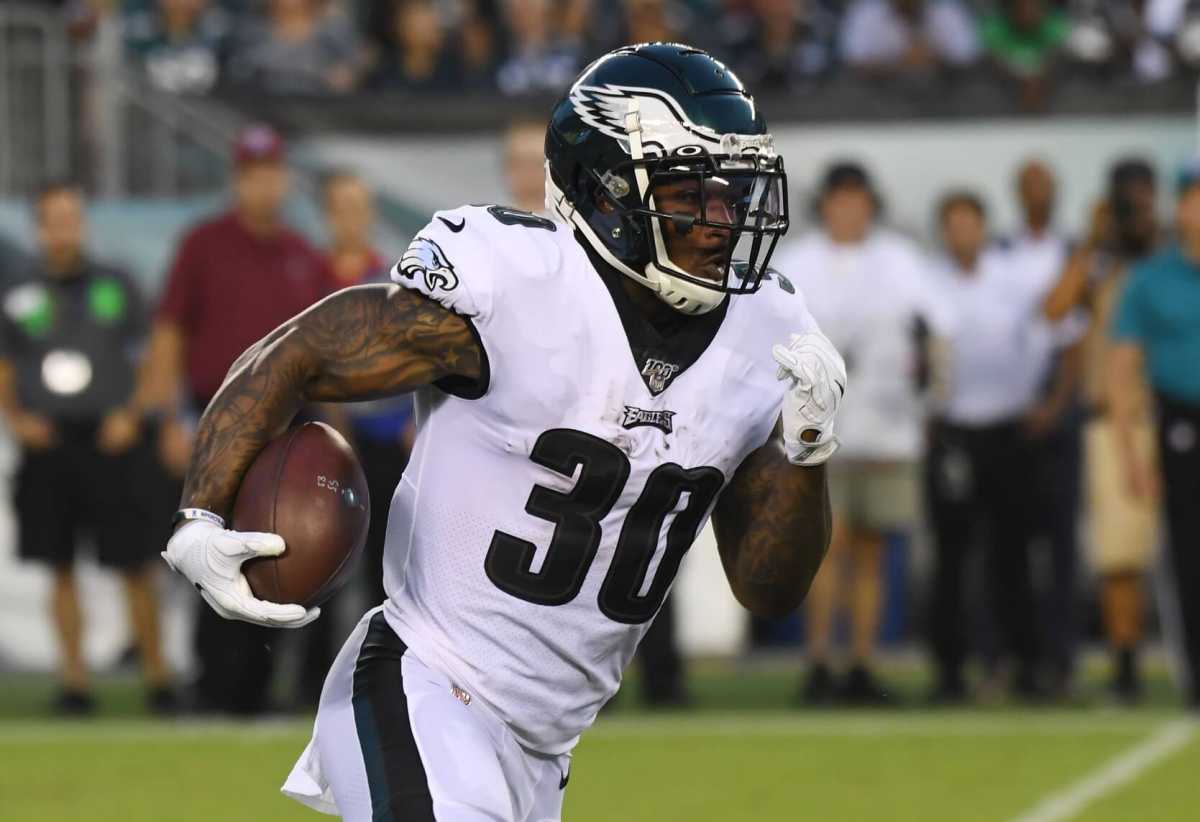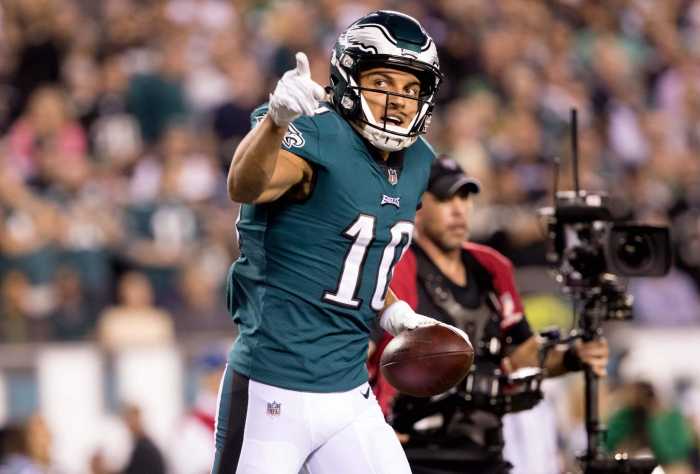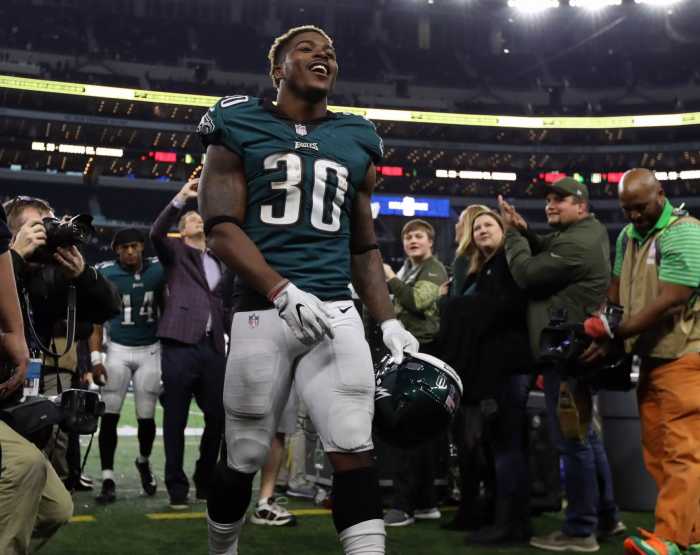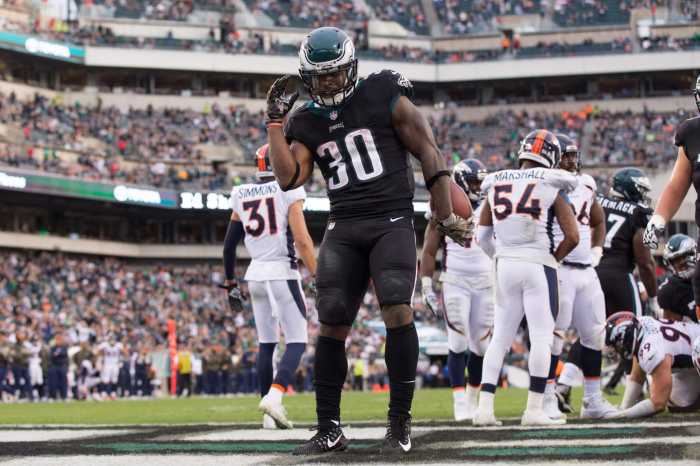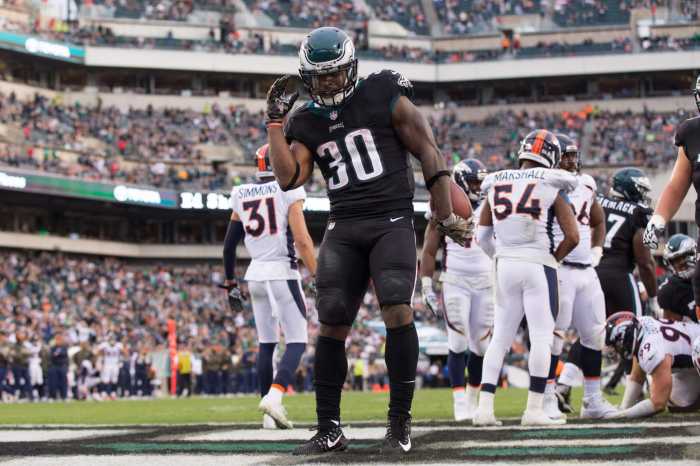With last year’s rookie sensation Miles Sanders and practice squad phenom Boston Scott announcing themselves to the NFL last season, much of the hype surrounding the Philadelphia backfield has focused on those two players. Along with the enticing addition of Elijah Holyfield late last season, there has been one name that has fallen out of the spotlight. It’s so easy to forget what Corey Clement is capable of with two seasons overshadowed by injury and a mixed bag of offensive game plans. At the very least, he can be a very serviceable rotational option for the Birds. At best? Well, let’s take a look.
The biggest question for Clement in his three-year career in the league has been to figure out exactly where he fits. In college, he was a bruising one-cut style runner that wore down the defense and was rarely asked to catch passes out of the backfield. Still, he showed bursts of speed in the open field and a nuanced understanding of gaps — something that made him more NFL ready than most UDFAs. Entering the NFL he was asked to cut weight and focus on his hands and route running. Before long he was a regular in the Eagles’ rotation as a 3rd down back; a full 180 in the span of just a year.
It’s not simply Clement’s improved ability as a pass-catcher that made him an essential part of Philadelphia’s Super Bowl run. It doesn’t take much time watching film to notice that he’s one of the more underrated pass blockers at the position. As a runner, he has the speed to round the edge of a defense and yet has the size, strength, and wherewithal to rarely be taken down for a loss. In fact, it would be painting him into an unfair box to say it is any one thing that makes him such a special player.
The Return
After an impressive rookie season, highlighted by an incredible performance in the Super Bowl, Clement’s second season was thought of as a disappointment. It’s a tad unfair as he raised his per game totals in almost every category as his role increased, despite missing five games.
| G | Car | Yds | Tds | Ctch | Tgt | Yds | Tds | |
| 2017 | 16 | 74 | 321 | 4 | 10 | 15 | 123 | 2 |
| 2018 | 11 | 68 | 259 | 2 | 22 | 25 | 192 | 0 |
In 2019 he played a total of three offensive snaps before finishing the season on IR. Still, there are many like myself that refuse to give up on Clement — the Eagles included. What makes him such a special back is what Thomas alluded to in his tweet: he can do a bit of everything. How many players in the league average three yards after contact and 150+ QB rating when targeted?
The biggest hurdle for Corey has been finding a rhythm. He has bounced his weight from 225 to 215 and back again, went from rotational player to first option and back, and went from primarily a receiver to a run-first option . . . and back. After all, it’s difficult to find a place for a player whose best virtue is his versatility. In 2020 he may finally have a place cut out for him.
The Eagles are primarily in need of an RB that can fight for short yardage. For Corey that will come naturally. He often shouldered that responsibility at Wisconsin as a workhorse runner. Nevertheless, Philadelphia will also need a player to spell Miles Sanders on certain pass blocking/catching plays and run Doug Pederson’s inside zone. In some scenarios that might be three backs. For the Eagles they are lucky to have a guy that can do all three — and he’s the third option in the rotation.
There is a window opening for Clement’s redemption season. Simply on paper, he will have a great shot to be a part of the rotation and we know that RB Coach Duce Staley loves the young man. Sharing small glimpses on social media, it seems as if he is not taking this opportunity lightly, Yet, there are other interesting wrinkles to add to the mix when considering Corey’s return to the field.
21 Personnel
The Eagles brought in a handful of new faces to add to their offensive coaching staff in an effort to revitalize and refurbish what is already a fairly avant-garde offense. It’s uncertain what changes may become of the offense as a whole, if any, however, Doug Pederson has always been experimental with formations and moving his players around. Now with multiple versatile backs on the roster, the Birds are in a better position than ever to feature two back packages.
Teams have been moving away from two-back sets (21 personnel) since the fullback position has fallen out of favor. However, in 2017 there was one team that used it more than any other. The 2017 San Francisco 49ers used two-back sets on 38% of their plays. Of course, they had the benefit of having fullback extraordinaire Kyle Juszczyk on the roster. Nevertheless, they also had new Eagles coach Rich Scangarello in house. Last season with Scangarello in Denver, the Broncos turned to 21 personnel 12% of the time, which was 4th most in the league (per Sharp Football).
The Eagles also added Marty Mornhinweg to their offensive coaching staff. With Mornhinweg as the offensive coordinator in Baltimore in 2017, the Ravens used the 11 personnel the least of any team in the NFL. Habitually the Ravens used tight end heavy sets and only deployed 21 personnel 3% of the time in 2017. However, they used 22 personnel on 12% of their snaps (2nd most). In 2018, the Ravens were second in the league in non-11 personnel groupings but turned to single back formations more often with Lamar Jackson eventually functioning as a second ball carrier in the offense. Still, they used 22 personnel more than most (8%).
On the other side of the coin, the Eagles ran a whopping 93% of their plays from either 12 (52%) or 11 (41%) personnel last season, attempting to take advantage of their talented tight end duo. That figure is unlikely to change for 2020. However, they ran only 2% of their plays from 21 personnel (per Sharp Football), instead preferring three tight end sets — if only slightly (3%).
That figure could easily change for this season. Going even further, we may also see a rise in 22 personnel. The Eagles could then keep both Goedert and Ertz on the field and pair them with two electric backs. Philadelphia used 22 personnel on just 12 plays (1%) last season and 3 plays (0%) the year before.
Now, traditionally, the 21 personnel package is reserved for teams that regularly feature a fullback or H back. However, we have seen some iterations of more modernized two back sets focused on creating mismatches for the offense. Always the innovators, the Patriots have been the team to watch in this regard.
Below you’ll see an example of a pass play run from a split back formation.
Now imagine the same play with a combination of Miles Sanders/ Boston Scott/ Corey Clement in the backfield. That’s the stuff of nightmares for defensive coordinators. A simple dump-off can easily turn into a big gain with any of those backs capable of adding chunks of yards after the catch.
21 personnel gets even more alluring when considering the mismatches the Birds can create by moving their runningbacks around the formation. We know that Doug Pederson loves to motion and move players around. Just the presence of two capable ball carriers on the field can cause confusion for the defense. Take a look at the video below. Even though it presents as a single back set, the Patriots have both Rex Burkhead and James White on the field.
Using a double motion the Pats are able to create two favorable matchups, a LB covering James White in the slot and a CB in the box now with gap fill responsibilities. In an RPO heavy offense such as the Eagles, this is a dream scenario.
How it all fits together
Now, why does this matter for Corey Clement? The Eagles already have Boston Scott and added Holyfield and two impressive UDFA’s to push for snaps behind Clement — it’s clear from his offseason training that he is not taking that lying down. What the fourth-year back brings to the table is versatility. Let’s look at a play in which the Eagles did turn to 21 personnel:
Ideally, would you want 5’6″, 203 pounds Boston Scott laying that lead block for Sanders? Likely not. It’s not saying he’s not capable, but Jordan Howard is a much more formidable force at 6’0″, 224 lbs. Corey is 5’10” and tips the scales at 220, although it’s rumored he’ll be back up around 225 for the 2020 season.
Conversely, you probably don’t want to ask a back like Howard or Holyfield to run an option route out of the backfield like the Patriots ran in the video above. Who can run those routes? Corey Clement.
Regardless, the possibility of running two RBs at the same time, whether to create mismatches in the passing or running game, or misdirection like in the play above is exciting.
It will likely still be Boston Scott that comes off the bench first, but the Eagles have always committed to a running back by committee and will have to account for Jordan Howard’s 280 snaps. Clement’s integration into the offense shouldn’t take away from Miles Sanders’ growth in the same way that adding a veteran back might. The same can be said for Scott. Having many eager mouths to feed is a good problem to have and it seems as if the best way for everyone to get their fill is by deploying two-back sets.
With Alshon Jeffery set to begin the season on the injury list and rookie Jalen Reagor and second-year J.J. Arcega-Whiteside still finding their NFL legs, the Birds may look to avoid 11 personnel sets in the early goings. Although two tight end sets will absorb the bulk of those snaps, Philadelphia is in prime position to get creative with their running backs and a revitalized Corey Clement may be just the man for the job.
Mandatory Credit: James Lang-USA TODAY Sports

